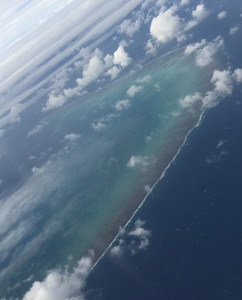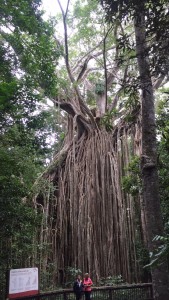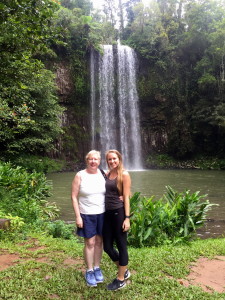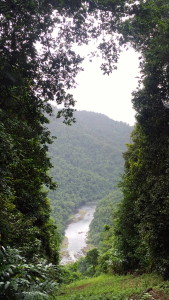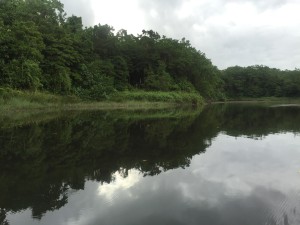Today we got to explore one of the oldest and most impressive parts of Australia, the Daintree Rainforest. Covering about 460 square miles, this national park layout is unique because is consisted of small irregularly shaped areas, rather than one large block of land. This rainforest is the largest continuous area of tropical rainforest on the Australian continent, with the rainforest extending all the way to the edge of the sea.
One unique story we were told tells the history of the Idiospermum australiense species, more commonly known as the idiot fruit. Essentially this tree was thought to have gone extinct many years ago, then was accidently rediscovered in 1970 by a farmer who was confused why his cows were dying from consuming this tree’s fruit. Named one of Australia’s most significant discoveries, this find identified that the Daintree Rainforest was far older than recorded, dating back 110 million years. Since evident of this species exists from that long ago, and it only grows in very specific and limited environments, this discovery was a huge mile marker for Australia.
Daintree River
Our day with Tropical Horizons tour group started with an hour and half drive to Port Douglas, following the edge of the ocean since only one main road links the two areas. Inland of the coastal area is very mountainous, so it makes sense that only main road runs along the edge. Despite what you might think, the road is very well kept and the drive is quite lovely with oceanfront views the entire way. After picking up the rest of the guests in Port Douglas, we drove through a residential area that was home to hundreds of wallabies and kangaroos, then headed to the first main stop at the Daintree River.
Here, we experienced the incredibly diverse ecosystem of the river. Within the first five minutes of our river cruise, we saw a saltwater crocodile and three baby crocodiles that were only 6-8 inches long! It was probably one of the cutest things I’ve seen on this trip. Although called saltwater crocodiles, majority of the species lives in freshwater. They get their name simply because they also have the ability to survive in saltwater. Later on we saw a larger crocodile, as well as a small snake in a tree, and a variety of birds. We learned about mangrove trees, which have vast root systems creating a swamp-like environment and wildlife haven among the water’s edge. Providing shelter and warmth, this creates the perfect living grounds for all sorts of flora and fauna. With only a little rain, our boat ride through the river was quite successful! We got off the boat upstream and on the other side of the river, where the bus picked us up again.

Baby crocodile (on center of lower half of branch)
Alexandra Lookout
Our next stop was Alexandra Lookout, also referred to as Walu Wugirriga by aboriginals. As you can see in the picture, it is absolutely stunning (sarcasm)! It was more than a little foggy due to the unfortunate weather, but you could still sort of make out the outline of the landscaping. With a clear view, this lookout offers views of the Daintree River mouth and it’s surrounding environment. We had just enough time to attempt a picture through the raindrops, then jump back on the bus.
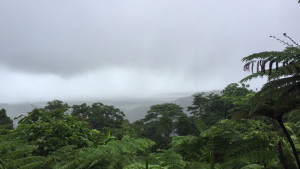
Alexandra Lookout
Rainforest Lunch
For lunch, all we were expecting was “lunch in a rainforest setting,” which in Australia is an extremely vague description, considering detailed descriptions here are often to be taken loosely. However, we enjoyed an absolutely beautiful lunch at a restaurant that is tucked away in the middle of nowhere in the rainforest. This small property also houses a resort, and has a restaurant literally set in the rainforest. It is built next to the river, and you can look over the edge and down onto the river right next to the dining tables. The staff was very friendly, and it was a fantastic meal! To make it more quaint, this restaurant was established a long time ago, before Cairns tourism developed, and was a typical spot for locals to stop by and enjoy a meal.
Cape Tribulation
Our second to last stop took us to the beach, at a point that was named by James Cook after his ship ran into some trouble there. Although his voyage was delayed, it was not ended, and he therefore named the point something representative of its nature, Cape Tribulation. By this point in the day, it was starting to just about pour buckets, so if anyone didn’t know how the rainforest got it’s name by then, they learned quickly. After a short walk on the beach learning the history of the point, we walked through the forest to a lookout point. Again, it was a bit foggy and rainy, but at least it felt appropriate to have this weather when visiting the rainforest!

Cape Tribulation lookout
Going off of that story, in case you’re wondering, here’s how Australia got it’s name. A long time ago, people knew the mapping of the North and South America’s, as well as the large European and Russian landmasses, so they assumed that in order for the world to balance out (in regards to land verses water masses), there had to be another land mass countering South America. When James Cook set out on his voyage from England, they had the idea that this land mass was wider and skinnier than it is now, and therefore he was sure to run into it when heading South. Although he did end up reaching what is now Australia, he had many unexpected adventures along the way that lead to many new discoveries. In the process though, Australia was originally named “Terra Australis Incognita,” or more simply and appropriately put, “the great undiscovered land.”
Mossman Gorge
Our last main stop of the day was Mossman Gorge, where we first enjoyed tea at the visitor’s center, then a short presentation by an Kuku Yalanji aboriginal. We took a shuttle to the park entrance, then followed the rainforest track walk to Mossman Gorge, passing over a suspended bridge along the way. Mossman is also known for its sugar cane farming, as many areas around Cairns are as well. Due to the fitting environment, sugarcane grows extremely well in this area, contributing to make Australia the world’s fifth largest producer of the sweet stuff. While harvesting used to be gathered by hand, now it is all processed by machinery to avoid infection by toxic waste products of rats living in the area. This change in methods caused the time limit of transporting the cut cane from the field to the mill from two weeks to a mere 14 hours. For this reason, small train lines run all across the countryside, because it is faster than transporting it on the limited roads with such a large volume of cane. Recently though, a successful sugar mill was bought by another company with the intention of solely trading ownership, then completely shut down after two months. This was done through the eyes of the competitor as a means to regulate the price. However, this devastated the town, which prided itself on the sugar mill business, and impacted a lot of lives and related businesses. This is just one example of how politics happen all over the world.

Mossman Gorge
Another interesting story of the day was learning that the company Palmolive started in the Daintree regions. Essentially, palm tree oil was mixed with olive oil, which was used as a base to make soaps. Two inventors, William Colgate and B.J. Johnson, joined forced to create a company for which they could both benefit from the credit and sales of a product. Therefore, Palmolive is not a name, but rather simply an addition of the words palm and olive.
Overall, we had a fantastic day learning about and exploring the incredible world of the ancient Daintree Rainforest!


